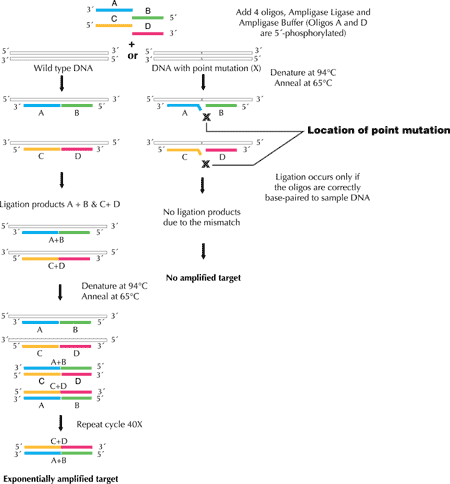Ampligase® Thermostable DNA Ligase catalyses NAD-dependent ligation of adjacent 3'-hydroxylated and 5'-phosphorylated termini in duplex DNA structures that are stable at high temperatures. Derived from a thermophilic bacterium, the enzyme is stable and active at much higher temperatures than conventional DNA ligases. Its half-life is 48 hours at 65°C and greater than 1hour at 95°C.

Ampligase® DNA Ligase has been shown to be active for at least 500 thermal cycles (94°C/80°C) or 16 hours of cycling. This exceptional thermostability permits extremely high hybridisation stringency and ligation specificity. Ampligase® DNA Ligase has no detectable activity in ligating blunt-ended DNA and has no activity on RNA or RNA:DNA hybrids.
Unit Definition:
One unit of Ampligase® DNA Ligase catalyses the ligation of 50% of the cos sites in 1µg of lambda DNA in 1 minute at 45°C in 1X Ampligase® Reaction Buffer.
Note:
One unit of Ampligase® DNA Ligase is equivalent to at least 15 of the 'cohesive end units' or 'nick ligation units' defined elsewhere.
Storage Buffer:
50% glycerol containing 50mM Tris-HCl (pH 7.5), 0.1 M NaCl, 0.1mM EDTA, 1mM DTT, and 0.1% Triton® X-100.
Ampligase® 10X Reaction Buffer:
200 mM Tris-HCl (pH 8.3), 250mM KCl, 100mM MgCl2, 5mM NAD, and 0.1% Triton® X-100.
Quality Control:
Ampligase® Thermostable DNA Ligase is assayed for the absence of blunt-end ligation activity by ligating SmalI-digested bacteriophage lambda DNA at 45°C; ligation occurs only at cos sites as determined by gel electrophoresis. Ampligase® DNA Ligase is free of detectable exo- and endonuclease and RNase activities.
 |
Figure 1. Schematic of mutation discovery and screening using ligation amplification. The existence of a point mutation at the site of ligation interferes with oligonucleotide ligation, resulting in no ligation product. The lack of an amplification product indicates the presence of a point mutation at the ligation site. Oligos can also be designed so ligation occurs in the presence of the mutant template |
 |
2. Ligation Amplification using Ampligase® DNA Ligase. Oligonucleotides A, B, C, and D from Figure 1 (25 pmoles each) were incubated as in Figure 1 with 5 units of Ampligase DNA Ligase in 25µl of 1 X Ampligase Reaction Buffer, with ( ) or without (-) 0.25 pmole DNA template. The reactions were cycled 40 times for 1 minute at 94°C and 2 minutes at 65°C, then separated by electrophoresis and visualized with ethidium bromide. In the presence of template DNA, the target sequence is amplified by formation of the ligation products A B and C D. |
Note: Some applications in which this product may be used may be covered by patents or patent applications applicable in certain countries. Because purchase of this product does not include a license to perform any patented application, users of this product may be required to obtain a license depending upon the particular application and country in which the product is used.
If you cannot find the answer to your problem then please contact us or telephone +44 (0)1954 210 200